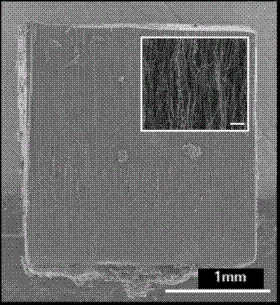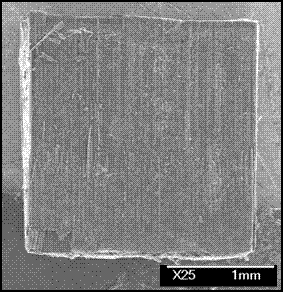Carbon Nanotubes Are Tougher and Supercompressible
11 Jul, 2007 12:54 pm
We show that under repeated high compressive strains, the long nanotube block shows a viscoelastic behavior similar to that seen in the soft tissue membranes. The large area nanotube block was compressed and release at a strain of 15% over half a million cycles and the nanotube block still retains its original structural integrity and its properties. The block shows viscoelastic behavior. Properly tailoring the nanotube block it could mimic artificial tissues and their excellent electrical conductivity could lead to variety of applications like electromechanical sensors.
There has been little work carried out on the fatigue properties of nanomaterials. In reality, the devices or materials undergo repeated stress for longer duration which eventually leads to their breakdown. For instance, carbon nanotubes do not have report on their fatigue behavior when subjected to real time applications.
In this work , we subject a block of carbon nanotube to mechanical compressive stress. We have created a free-standing, macroscopic, two-millimeter square block of carbon nanotubes (2.5 mm tall) made up of millions of individual, vertically aligned, multiwalled nanotubes. The nanotube block was then compressed between two steels plates in a vice-like machine. This is essential since the realistic applications undergo many repetitive stresses or strain on them, which eventually leads to the failure of the materials. Based on the mechanical compression and releasing the nanotubes behave like supercompressible springs. The mechanical stress – strain curve shows a viscoelastic behavior (although the individual nanotubes are not themselves viscoelastic) and this is often observed in soft-tissue materials. For eg. Tendons has a multilevel fibrous organization and exhibit quasi –incompressible properties. These tendons are subjected to undergo large deformations of upto strain levels of 10%, but they still retain their original structural integrity over a life time.
The CNT block is basically a collectiveness of individual carbon nanotubes (analgous to millions of bamboo shoots in a forest) is subjected to large compression cyclic strain ( i.e. cycles of sequential loading and unloading) for 500,000 cycles. Even after 500,000 cycles the nanotube block still retains its original structure with a slight reduction along the length of the CNTs. Since these CNT block exhibit multifunctional properties, these block was also simultaneously measured electrical when the mechanical compression and release is carried out. This demonstration is only a base line for the possible failure of the nanotubes but not the ultimatum. This shows that CNTs can withstand large stress or strain levels and can withstand a large number of cycles still maintaining its true properties. This CNT block will definitely be useful for real time applications and its potential uses in synthetic biopolymers, electromechanical sensors and contact brushes.
The authors involved in this work are Victor Pushparaj and Jonghwan Suhr, contributing equally to the paper, and the other authors of the paper include Prof. Pulickel Ajayan, Henry Burlage Professor of Materials Science and Engineering at Rensselaer Polytechnic Institute, NY; Prof. Omkaram Nalamasu, professor of chemistry and materials science and engineering at Rensselaer Polytechnic Institute, NY; Dr. Lijie Ci, Rensselaer research associate at Polytechnic Institute, NY; Dr. Subbalakshmi Sreekala, Research associate in the department of mechanical and aerospace engineering at Princeton University; and X. Zhang, research associate in the school of materials science and engineering at Shanghai Jiao Tong University.
Reference :
J. Suhr, et al., Nature Nanotechnology, 07/07
Figures

A two-millimeter square block of carbon nanotubes, made up of millions of individual, vertically aligned, multiwalled nanotubes. Credit: Rensselaer/Victor Pushparaj
 The same carbon nanotube block after being compressed more than 500,000 times. Even after this stress, there is virtually no difference in the block’s shape, mechanical integrity or electrical conductivity. This resistance to wear and tear is similar to the behavior of soft tissues such as a shoulder muscle or a stomach wall.Credit: Rensselaer/Victor Pushparaj
The same carbon nanotube block after being compressed more than 500,000 times. Even after this stress, there is virtually no difference in the block’s shape, mechanical integrity or electrical conductivity. This resistance to wear and tear is similar to the behavior of soft tissues such as a shoulder muscle or a stomach wall.Credit: Rensselaer/Victor Pushparaj






Mechanical properties of carbon nanotubes bulk nanostructures were described. Such a study is one forward step towards the application of carbon nanotubes in real world.
I have modified the abstract and the body of text appropriately. The
second figure is not correct, hence i deleted the second figure and tried
to upload the new figure to the website. It wasnt getting uploaded.
Please find the second figure attached along with this mail. Please
upload it and then it completes the paper.
Kindly let me know in case if you require anymore information.
thanks
with warm regards
victor
[Response] I updated the second figure. The article will be published today. Regs, Gilles.
(1) since the authors considered a large ensemble of cnt s, it is useful to have an estimate of mean and standard deviation of the diameter of the cnt s that constitute the sample. The porosity of the block (or inter-nanotube separation) is another parameter that characterizes the sample. Does the block contain both metallic and semiconducting cnt s? In this case the electrical resistance will be solely determined only by the low resistance cnt paths instead of all cnts in the block.
(2) Did the authors inspect (via TEM) at least some of the individual cnt s after large number of cyclic mechanical loading? It will be interesting to see what kind of defects are developed due to mechanical stress.
Thank you,
[Response] Thanks for the queries. Ans to Queries (1) Kindly find the details of the porosity (~ 8-13% CNTs) and diameter (~ 65 nm) distribution in the supplementary section of Nature nanotech (July2007 issue). The nanotubes in this case is MultiWalledNanoTubes (MWNTs). (2) We are studying the defects developed due to cyclic mechanical loading at nanoscale.